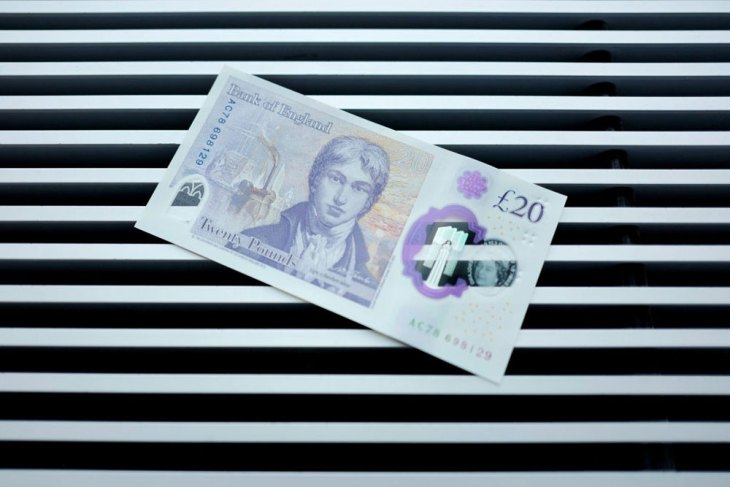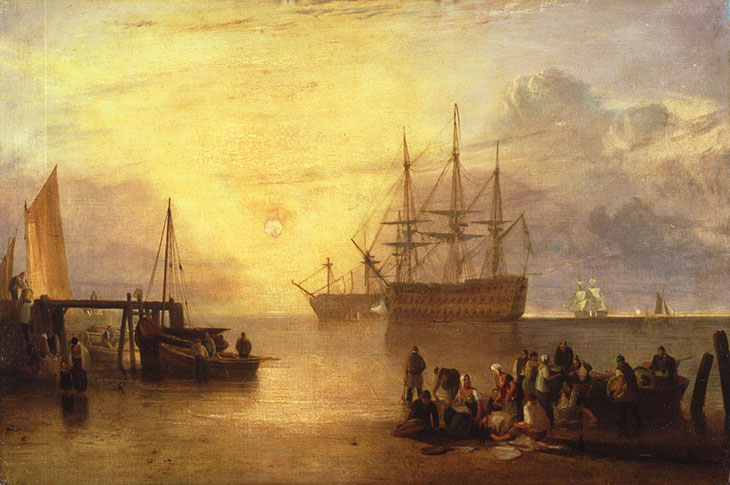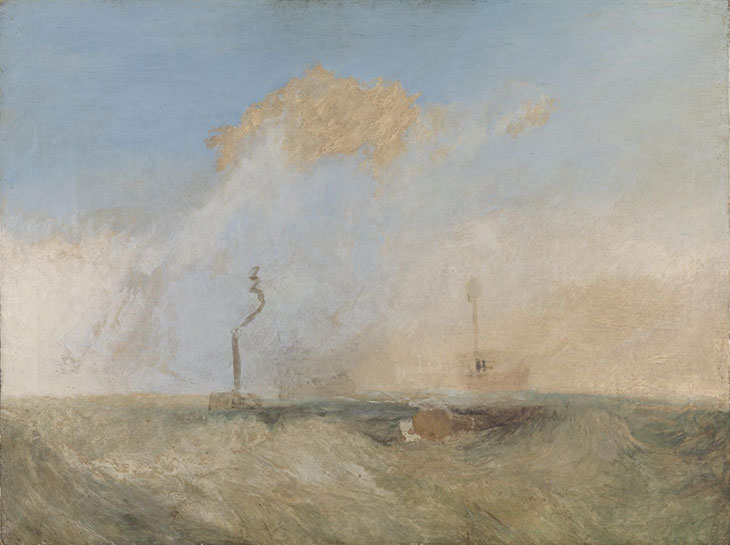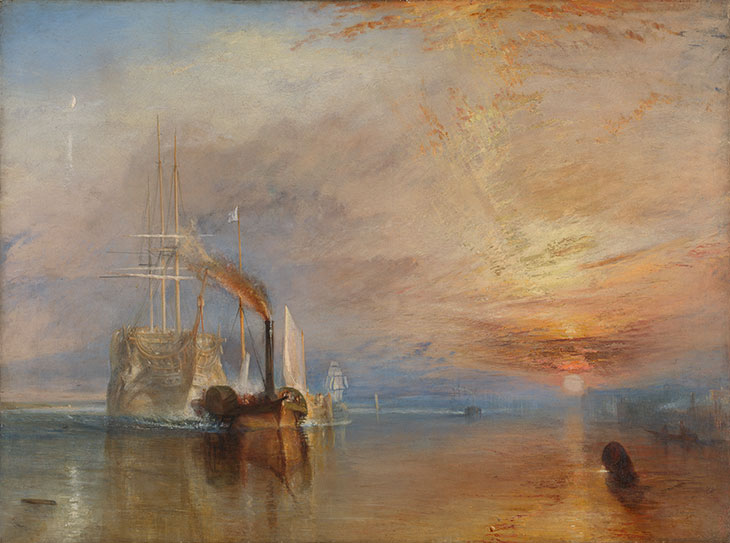After a long development process, on 20 February the Bank of England introduced its new polymer £20 note, featuring the face of J.M.W. Turner overlaid on to his most famous painting, The Fighting Temeraire, tugged to her last berth to be broken up, 1838. The elegiac scene of the obsolete, formerly fêted battleship acts here as Turner’s calling card, effectively summarising his overall achievements.
Indeed, once it had been determined that Turner would be the face on the new note, the decision to select the Fighting Temeraire, by designer Debbie Marriott and her colleagues at the Bank of England, was guided by the results of the ‘Greatest Painting in Britain’ poll organised by the BBC in 2005, in which the picture had triumphed in the public vote. It attracted nearly 32,000 votes, a comfortable 10,000 ahead of Constable’s pastoral vision of England, The Hay Wain (1821). Admirers of the latter artist might cynically suggest that the vote was conducted in the same year as the 200th anniversary of the Battle of Trafalgar, in which HMS Temeraire had played a heroic role in the weather column at the heart of the action, and that Turner’s painting was buoyed in the poll by a wave of resurgent patriotism. More recently, the combination of rough-handed naval prowess and technological advancement celebrated in Turner’s picture made it a natural reference point for that other great embodiment of British nonchalance and pride, James Bond, in the film Skyfall (2010). Turner’s metaphor of the inevitability of youth and innovation overtaking age and experience seemed to provide there a sharp reminder that even Bond, perhaps, has a limited shelf life (although – spoiler alert – as the usual association of ships with feminine identities might have indicated, it is actually a more senior figure in the ranks of British intelligence, Judi Dench’s M, who should be worried about her fate).
Photo: Leon Neal/Pool/AFP via Getty Images

Both uses of the Temeraire image rely on familiarity, coupled with a fundamental nostalgia for the passing of great things; and, more broadly, the passing of time. There are no figures in this landscape to direct our emotions in the manner of Paul Delaroche’s hugely popular portrayal, in 1833, of Lady Jane Grey as she, like the Fighting Temeraire, awaits her execution (displayed just a few rooms away from Turner’s picture at the National Gallery in London). And yet viewers have consistently felt profound compassion for the creaky old vessel ever since the painting was first exhibited at the Royal Academy in 1839.
This sentiment is stirred so powerfully that admirers have resisted numerous attempts to demonstrate that what Turner represents is not a straightforward record of the event it depicts, but actually a poetic concoction – a ‘splendid lie’, to borrow the phrase used (in Latin) by George Jones, one of his best friends, in a subversive caption to his depiction, exhibited in 1823, of the Bay of Baiae (now in the Tate). On that occasion, Turner embellished his already sumptuously gilded coastal landscape with the mythical figures of Apollo and the Sybil. Both that picture and the Fighting Temeraire reveal how Turner could be boldly modern in his imagery and in technical matters, such as his colouring, while still honouring traditional methods of composing a picture in the imagination from a combination of fragments of first-hand and accumulated sources. This composite approach was certainly the position he endorsed in the lectures he gave at the Royal Academy.
Even so, for much of the time the Fighting Temeraire has hung on the walls of the National Gallery visitors have been encouraged to view the painting as a kind of journalistic transcription of what Turner would have seen as the warship was tugged upriver on 5–6 September in 1838. He had, after all, created two vivid recreations of the destructive fire in the Houses of Parliament which he certainly witnessed in 1834. So in seeking to cement the belief in the Fighting Temeraire as a form of reportage, after his death assorted voices readily furnished accounts of Turner studying the ship’s passage, either as he made his way back from Margate, or while sketching at a pub in Bermondsey. A further tale placed him on the river at Greenwich with artist friends including Clarkson Stanfield, who was alleged to have proposed to Turner that the event would make a noble subject. Such testimonies, however, have all proved flawed, not least because Turner seems likely to have been far away, on the Mediterranean coast, at the time the tow took place.
An extensive list of factual inaccuracies in the image was compiled in the catalogue to an exhibition curated by Judy Egerton at the National Gallery in 1995. These ranged from fundamentals, such as that the Temeraire had no masts in place at the time, and the steamboat’s mast is positioned inaccurately (and dangerously) behind its spouting funnel, to more atmospheric concerns about the impossibility of a sunset being visible at any time during the journey upriver, and the fact that the date of the event coincided with a full moon, not the sliver of a new moon as rendered by Turner. Together, these embellishments nudge the viewer towards instinctive and sometimes conflicting responses: the sad sense of finality versus the hope of a new dawn; a confrontation with the ugliness of industry versus a celebration of the innovative dynamism of steam travel. No one interpretation suffices.
Coast Scene – Sunset, with men-of-war at anchor; fine weather (formerly known as The Sun Rising through Vapour) (c. 1809), J.M.W. Turner. © The Barber Institute of Fine Arts, University of Birmingham

There is a similar tendency to lyricise in a pair of works Turner painted around three decades earlier for his friend and patron Walter Fawkes. The more famous of the two, now in the collection of the Yale Center for British Art in New Haven, shows Nelson’s flagship, HMS Victory, in a rather more pristine and triumphant state than was the reality as it carried the admiral’s body back to Britain after Trafalgar. Less well known is the picture that was created and hung as its pendant, now in the collection of the Barber Institute in Birmingham. Without the kind of official title conferred when Turner publicly exhibited one of his paintings, this canvas has generally been referred to as The Sun Rising through Vapour. However, in the earliest catalogue of the Fawkes collection, it was actually described as ‘Coast Scene – Sunset, with men-of-war at anchor; fine weather’. This shift from sunrise to sunset inevitably alters our perception of what is happening. It now becomes clear that the smoke near the centre of the image indicates the firing of the evening gun on the hulk behind the main vessel to mark the lowering of its last flag. This detail takes on a more specific symbolic character once the depiction of this vast first-rate man-of-war is connected with sketches Turner made of the Victory while it was moored at Long Reach on the Medway in December 1805, after Nelson’s body had been ceremoniously unloaded. This identification of the main vessel as the Victory creates a new and meaningful link with the picture at Yale. It seems that Turner intended the sunset painting as a sequel to the better-known canvas, a quietly moving scene of final homecoming for the nation’s hero (perhaps we are even meant to think of this as the very moment the great admiral was taken from his ship). By distorting the physical reality of the battered and stripped-down Victory to restore its 104 guns to the ports of its three decks, he reinvested it with an appropriate dignity and power. Presumably in the private setting for which the painting was conceived the message was implicit to its first owner, without the need for dramatic grandstanding. Nevertheless, these sleights of hand stem from the same impulse behind the ghostly imperiousness of the Fighting Temeraire; to create an apotheosis, or heightened idea of the significance of the subject evoked.
A Steamer towing the Fighting Temeraire near a Lightship off Sheerness (c. 1825–30), J.M.W. Turner. Currently on view in ‘The Sea and the Alps: Turner’s Quest for the Sublime’ at Frist Center for the Visual Arts, Nashville. Photo: © Tate/CC-BY-NC-ND 3.0 (Unported)

Turner’s absence from Britain at the time the Temeraire made its last voyage up the Thames was evidently not in itself a handicap to his desire to paint the subject. He had seen the ship many times over the years, whether moored as an ignominious prison hulk on the Tamar near Plymouth during his tours of Devon, or later stationed as a guardship off Sheerness as he made his way to and from Margate by the steam packet. The latter experience seems to have shaped his thoughts when he made what is believed to be his first attempt at representing the Temeraire’s last journey from Sheerness to Rotherhithe: one of the unfinished canvases in the Turner Bequest, found in the basement of the National Gallery among a batch of dirty and uncatalogued works during the Second World War. This was known by the descriptive title Steamer and Lightship until the Pantzer Lecture of 2004, when it was proposed that the unresolved picture should be considered a first essay for the Fighting Temeraire subject. On the left side Turner indicated the positions of a tugboat, with its polluting funnel, pulling the indistinct hulk of a man-of-war. These elements are balanced on the other side by the broadside silhouette of another former battleship, its masts trimmed and repurposed to provide fixed lights to aid navigation at an important defensive point on the river. The running waves and blustery clouds, as far as Turner developed them, are reminiscent of his picture of the same setting, The Confluence of the Thames and the Medway (exhibited in 1808). That earlier image features the tan-coloured sails of the local fishing boats, which an X-radiograph of the Fighting Temeraire has shown were a preliminary component of the scene Turner began to work out on that canvas before embarking on the well-known image.
A further connection between the unfinished scene near Sheerness and its more celebrated sibling was found on the reverse side of its canvas, where Turner drafted in chalk some lines of poetry evidently growing out of his work on the Temeraire subject. Although now almost illegible, the text seems to open by evoking the light of glory now blushing red with disgrace, before moving on to say something like ‘She might have been spared with the [?hearts] of oak’. It does not seem fanciful to assume he was reaching here for a way of augmenting his image by invoking the widespread opinion that veteran survivors of the great victory at Trafalgar, like the Temeraire, deserved greater respect, and should be preserved. But these musings evidently never found satisfactory form, for when Turner exhibited his finished painting at the Royal Academy he supplemented its title in the catalogue with an amended quotation from Thomas Campbell’s ‘Ye Mariners of England’: ‘The flag which braved the battle and the breeze, /No longer owns her.’ The second line was Turner’s own, referring to the fact that, after being sold by the navy, the Temeraire’s hulk was effectively orphaned, and could no longer legitimately fly the Union flag. This crucial absence in the image served as a means of interjecting something of his own sense of injustice at the ship’s inglorious fate. It is ironic that this great national icon conceals a stinging reproach. But it is typical of Turner’s ability to juggle ambiguity that even this lament is couched in one of his most transcendent and peaceful compositions.
The Fighting Temeraire tugged to her last berth to be broken up, 1838 (1839), J.M.W. Turner. © The National Gallery, London



